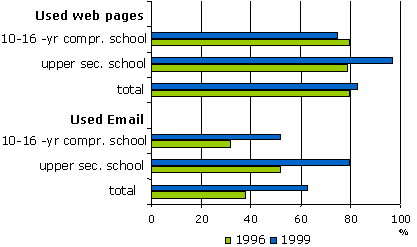Network Learning

|
The main aim of the Finnish education system is to ensure that the entire population
has access to education and training. The principle of lifelong learning, the idea that
people are always capable of learning new things at all stages of life, is an important principle
for all education provision, from basic schooling to adult education. Finnish people have a high
standard of education. Young people, in particular, have been rated very highly in international
comparisons.
|
|
Schools’ Access to Information and Communication Technologies (Stage 3)
In Finland over 90% of the schools were already connected to networks in 19992.
A lot of public money was given to schools in the late 1990s for investing in
information technology. In autumn 1999, only one fifth of the school pupils aged
over 10 had not used a computer at school in the August-November period2. Many
children and young persons had also browsed web pages from school at least on
some occasion and almost all upper secondary school pupils had done so. Upper
secondary school pupils already searched the Internet almost routinely for
information to help with schoolwork. Almost half of them said they also used
teaching materials available on-line. This kind of information searching was
clearly less frequent at comprehensive schools. The existence of an Internet
connection is a prerequisite to the use of information networks becoming part of
normal routines. In this sense, upper secondary school pupils had distinctly
more frequent access to information networks outside school hours than
comprehensive school pupils.
Percentages of pupils who had used computers for email and web pages at school in 1996 and 1999

|
Enhancing Education with ICTs (Stage 3)
In Finland a five-week in-service training program discussed technology in the education sector with
10,000 teachers. This in-service, held between 1996 and 1999 resulted in some interesting finding. 50% of the
teaching staff on all levels is expected to acquire good ICT skills by 2004. But
although effort is being put into teacher training, the actual use of ICT in
daily teaching remains an aim for the future. Only about 20% used ICT in their
daily teaching. The curriculum also requires that all pupils in comprehensive
schools shall acquire basic ICT skills, integrated in a variety of subjects.
Media literacy shall become part of general Finnish education by
20049. In Finland, the virtual university that has been under
development for about the past three years has not made its breakthrough.
Finnish universities have placed some of the education on the net, but a
nationwide virtual university is only at the beginning. This is a key area
Finland needs to develop.
All Finnish schools are connected to the Internet (Ranking in Internet Access in Schools: 1). These
networked schools offer online administrative functions such as course
enrollment and grading as well as online classes and tutorials at the high
school and university levels. Computer facilities for games and learning are
even provided in public daycare and preschool facilities.
|
Developing the ICT Workforce (Stage 4)
Finnish Nokia has used the virtual learning environment as of 2002. The teacher
and the students are connected to each other in real time with the Intranet,
using headphones and microphones to discuss with each other, with the VoIP
technology11. There are many technical schools that focus on technology
development, online training, and universities that provide degrees with the ICT
future needs in mind.
In addition to a high penetration
of Internet access in households and workplaces, Finland has a well developed
infrastructure for public access to the Internet (PIAP) via libraries and other
public places (Ranking in Public Access to the Internet: 2). Between 1995 and
1999, the government provided almost US$250,000 per year per village for rural
areas to subsidize ICT equipment and personnel. When considered together with
regional programs such as Tietotupa (information huts), which provide communal
access to the Internet and other technologies, an expansive system of access is
evident throughout Finland2 The government has stressed the importance of its
Information Strategy for Education and Research 2000–2004, created to provide
ICT access and literacy training for those in need, with priority given to the
poor and minority groups.

|
|